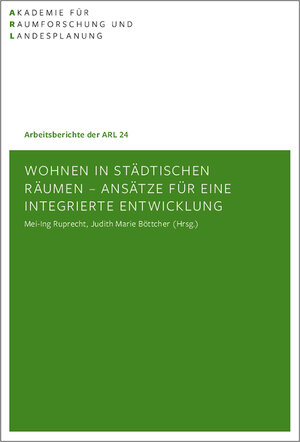
×
![Buchcover ISBN 9783888384189]()
Wohnen in städtischen Räumen - Ansätze für eine integrierte Entwicklung
herausgegeben von Mei-Ing Ruprecht und Judith Marie BöttcherHousing in urban areas – Approaches for integrated development
In light of global and local or regional transformation processes, providing appropriate
and sufficient housing in urban and suburban areas is a particular challenge for
sustainable urban and regional development. In addition, the capabilities of the municipalities
and conditions on the housing market have changed significantly. Hence,
the need for integrated planning of housing in urban districts, cities and regions is increasingly
urgent.
The working group ‘Integrated Planning of Housing in Urban Areas’ understands the
integrated development of housing as a process that should ideally ensure the simultaneous
organisation and coordination of the four dimensions ‘levels’, ‘actors’ ‘resources’
and ‘fields of action’. Members of the working group were concerned with
finding new approaches to harmoniously coordinate these four dimensions. The
working group traced the rationale of relevant actors, investigated different types of
cooperation, and identified obstacles and success factors of cooperation. This showed
the contribution of cooperative approaches for the integrated planning of housing.
Furthermore, two comparative case studies presented an urban-regional exchange of
planning information. One success factor for the implementation of the integrated
development of housing, as demonstrated by both focuses of research, is the use of a
mixture of informal and formal instruments. The working group added two playful
approaches to improve knowledge transfer among younger target groups. First, a
scientific comic deals with conflicts and opportunities in the development of housing
stocks. Second, a simulation game offers the opportunity to experience a fast-motion
planning process full of conflicts to develop an inner-urban brownfield site.
In conclusion, ‘integrated planning’ of housing was seen to be both a learning process
in cooperative action and a joint goal-setting process. A cooperative planning process
for integrated housing provision and development becomes feasible when actors
adopt new perspectives and are willing to overcome boundaries of individual departments
and systems. In face of changing conditions, this requires continuous consideration
of current tasks and possible solutions, and examination of the local opportunities
and barriers to actual implementation. With this publication, the working group
contributes to further development of the topic for both practice and academia.
In light of global and local or regional transformation processes, providing appropriate
and sufficient housing in urban and suburban areas is a particular challenge for
sustainable urban and regional development. In addition, the capabilities of the municipalities
and conditions on the housing market have changed significantly. Hence,
the need for integrated planning of housing in urban districts, cities and regions is increasingly
urgent.
The working group ‘Integrated Planning of Housing in Urban Areas’ understands the
integrated development of housing as a process that should ideally ensure the simultaneous
organisation and coordination of the four dimensions ‘levels’, ‘actors’ ‘resources’
and ‘fields of action’. Members of the working group were concerned with
finding new approaches to harmoniously coordinate these four dimensions. The
working group traced the rationale of relevant actors, investigated different types of
cooperation, and identified obstacles and success factors of cooperation. This showed
the contribution of cooperative approaches for the integrated planning of housing.
Furthermore, two comparative case studies presented an urban-regional exchange of
planning information. One success factor for the implementation of the integrated
development of housing, as demonstrated by both focuses of research, is the use of a
mixture of informal and formal instruments. The working group added two playful
approaches to improve knowledge transfer among younger target groups. First, a
scientific comic deals with conflicts and opportunities in the development of housing
stocks. Second, a simulation game offers the opportunity to experience a fast-motion
planning process full of conflicts to develop an inner-urban brownfield site.
In conclusion, ‘integrated planning’ of housing was seen to be both a learning process
in cooperative action and a joint goal-setting process. A cooperative planning process
for integrated housing provision and development becomes feasible when actors
adopt new perspectives and are willing to overcome boundaries of individual departments
and systems. In face of changing conditions, this requires continuous consideration
of current tasks and possible solutions, and examination of the local opportunities
and barriers to actual implementation. With this publication, the working group
contributes to further development of the topic for both practice and academia.


